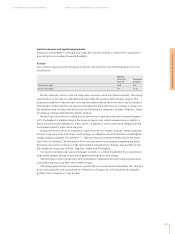Siemens 2005 Annual Report Download - page 121
Download and view the complete annual report
Please find page 121 of the 2005 Siemens annual report below. You can navigate through the pages in the report by either clicking on the pages listed below, or by using the keyword search tool below to find specific information within the annual report.
121
Accounts receivable – The allowance for doubtful accounts involves significant management
judgment and review of individual receivables based on individual customer creditworthiness,
current economic trends and analysis of historical bad debts on a portfolio basis. For the deter-
mination of the country-specific component of the individual allowance, we also consider country
credit ratings, which are centrally determined based on information from external rating agen-
cies. Regarding the determination of the valuation allowance derived from a portfolio-based
analysis of historical bad debts, a decline of receivables in volume results in a corresponding
reduction of such provisions and vice versa. As of September 30, 2005 and 2004, Siemens record-
ed a total valuation allowance for accounts receivable of €981 million and €918 million, respec-
tively. Siemens also selectively assists customers, particularly in the telecommunication equip-
ment area, through arranging financing from various third-party sources, including export
credit agencies, in order to be awarded supply contracts. In addition, the Company provides
direct vendor financing and grants guarantees to banks in support of loans to Siemens customers
when necessary and deemed appropriate.
Goodwill – SFAS 142 requires that goodwill be tested for impairment at least annually using a
two-step approach at the division level. In the first step, the fair value of the division is compared
to its carrying amount including goodwill. In order to determine the fair value of the division,
significant management judgment is applied in order to estimate the underlying discounted
future free cash flows. In the case that the fair value of the division is less than its carrying
amount, a second step is performed which compares the fair value of the division's goodwill to
the carrying amount of its goodwill. The fair value of goodwill is determined based upon the dif-
ference between the fair value of the division and the net of the fair values of the identifiable
assets and liabilities of the division. If the fair value of goodwill is less than the carrying amount,
the difference is recorded as an impairment. As of September 30, 2005 and 2004, Siemens had
total goodwill of €8.930 billion and €6.476 billion, respectively. For more information, see “Notes
to Consolidated Financial Statements.”
Pension and postretirement benefit accounting – Our pension benefit costs and credits
are determined in accordance with actuarial valuations, which rely on key assumptions including
discount rates and expected return on plan assets. We determine the market-related value of plan
assets for the majority of our domestic pension plans based on the average of the historical mar-
ket values of plan assets over the four quarters of the preceding fiscal year. This value is the basis
for the determination of the return on plan assets and amortization of unrecognized losses in
the fiscal year following the actuarial valuation. For all other pension plans, asset values are based
upon the fair value of plan assets at the measurement date. Due to the underfunded status,
measured against the accumulated benefit obligation (ABO), of certain pension plans at their
respective measurement dates, an additional minimum liability may result, which is generally
recorded net of deferred income tax assets in accumulated other comprehensive income. If an
additional minimum liability has to be recorded, the amount will be determined at the respective
measurement date on a plan-by-plan basis. Our postretirement benefit costs and credits are
determined in accordance with actuarial valuations, which rely on key assumptions including dis-
count rates, and increase or decrease in health care trend rates. The discount rate assumptions
reflect the rates available on high-quality fixed-income investments of appropriate duration at the
measurement dates of each plan. The expected return on plan assets assumption is determined
on a uniform basis, considering long-term historical returns, asset allocation, and future esti-
mates of long-term investment returns. Other key assumptions for our pension and postretire-
ment benefit costs and credits are based in part on current market conditions. Pension and relat-
ed postretirement benefit costs or credits could change due to variations in these underlying key
assumptions.
Management’s discussion and analysis
Consolidated Financial Statements Notes to Consolidated Financial Statements
























